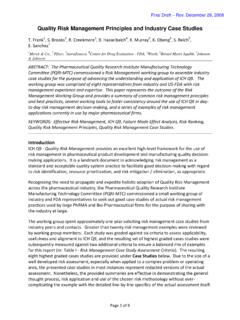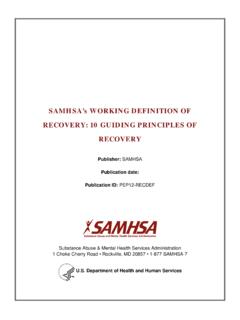Transcription of Principles for Public Management Practice: From ...
1 Principles for Public Management Practice: From Dichotomies to Interdependence MARTHA S. FELDMAN* AND ANNE M. KHADEMIAN**1. In this essay we explore the relationship between Management practices and a basic governance dilemma: how to manage flexibly and accountably. The challenge is both practical and theoretical. Managers must respond flexibly to the changing demands and expectations of the Public and the ever- changing nature of Public problems, yet they must do so in a manner that provides accountability to the Public and political overseers. A dichotomous approach to the study of leadership as Management action and the gover- nance structures within which managers operate has inhibited the search for a Public Management theory that reconciles the dilemma.
2 Emphasis upon managers as leaders typically focuses on the flexible actions managers might take to overcome structural barriers, while emphasis upon gover- nance structures typically focuses on the essential role of structure in ensuring accountability and restraining or motivating particular manage- ment efforts. The practicing manager, however, cannot deal with these aspects of the work separately. Managers must attend to demands for both flexible leadership action and structures that promise accountability. Anecdotal evidence provides illustrations of some of the ways that manag- ers can integrate these demands. We suggest that these efforts point to an alternative theoretical framework that understands action and structure as mutually constitutive, creating a dynamic tension in which attention to one requires attention to the other.
3 INTRODUCTION. The world of Public managers today is radically different from that of a few decades past (Nalbandian). On the one hand, managers face tremen- dous expectations for greater flexibility in the Management of Public pro- grams. Communities are increasingly heterogeneous, economies and communications are more accessible and global, connections and partner- ships between organizations, the Public and private sectors, and policy arenas multiply, and members of the Public are better able to scrutinize government performance and demand improved performance. Tradi- tional governance structures built upon command and control *Department of Political Science and Gerald R.
4 Ford School of Public Policy, University of Michigan **Robert A. Fox Leadership Program, University of Pennsylvania Governance: An International Journal of Policy and Administration, Vol. 14, No. 3, July 2001. (pp. 339 361). 2001 Blackwell Publishers, 350 Main St., Malden, MA 02148, USA, and 108. Cowley Road, Oxford, OX4 1JF, UK. ISSN 0952-1895. 340 MARTHA S. FELDMAN AND ANNE M. KHADEMIAN. organizations, centralized rule structures, and formulaic policy responses do not function well in this new environment, which demands flexibility. At the same time, however, these traditional governing structures have been put in place for good reason.
5 They have long provided a form of accountability, legitimacy, and sense of direction for Public organiza- tions. While flexibility is becoming essential, the Public is not willing to forsake accountability to achieve it. Confronted with antiquated systems of governance, managers must exercise leadership, but not in an any- thing goes manner. In short, managers face the challenge of developing an alternative form of accountability that allows for greater flexibility of action. Finding such an alternative is a modern Management dilemma (Behn). A PRACTICAL AND THEORETICAL DILEMMA. The accountability-flexibility dilemma has its roots in the earliest Ameri- can efforts to develop a field of Public administration practice and schol- arship.
6 While there were important differences between reformers, several prominent ones emphasized both vigorous leadership and struc- tural and procedural reforms as the key to better performing government. In 1887, for example, Princeton professor Woodrow Wilson argued that strong leadership visibly exercised would be accountable leadership: There is no danger in power .. [I]f it be centred in heads of the service and in heads of branches of the service, it is easily watched and brought to book (Wilson, 76). Wilson and others viewed the flexible exercise of authority by leaders and top managers as essential to the effective opera- tion of administrative systems and implementation of administrative pro- cedures (Behn).
7 Wilson made his argument for vigorous administrative leadership in the context of his own parallel efforts and those of others to make the business of government more efficient and accountable in its conduct through structural and procedural reforms. From the design of city governments (Bruere; Schiesl) to the search for scientifically derived prin- ciples of administrative procedure (Goodnow; Gulick and Urwick), reformers looked to the role organizational structure and administrative procedure might play in the efficient and accountable execution of government. In other words, good government demanded vigorous and visible leadership as well as proper governing structures to insure that the Public interest was pursued both creatively and accountably.
8 Rather than pursue the study of administration through both lenses simultaneously, however, the young field of Public administration focused much of its attention on structural and procedural design of orga- nizations and organizational systems as key to good Management (Knott and Miller; Roberts 1994).2 The study of leadership, where the adjectives entrepreneurial, innovative, flexible, and creative referred to business leaders revered for their accomplishments in the marketplace, Principles FOR Public Management PRACTICE 341. became a more fundamental concern for business scholars and practitio- ners (Barnard). Across the twentieth century, politicians and scholars interested in reforming Public administration looked toward the exercise of leadership in the private sphere (such as that of Peter Grace, head of the Grace Commission) to set the tone for government reform.
9 Historians ( , McGraw) pointed to several Public administrative leaders who broke the mold of conservative and compliance-oriented leadership some a bit too exuberantly (see Lewis). However, with a few exceptions ( , Kaufman), the study of administrative leadership has remained somewhat disconnected from the study of administrative systems. The current debate over the new Public Management also perpetuates a dichotomous approach between a focus on leadership or structure. Some approaches to this movement emphasize releasing and enhancing the capacity of managers to lead; others emphasize changing structures to shape or influence Management actions.
10 As Donald Kettl points out, the American version of new Public Management supports greater manage- ment flexibility. Structures such as rules, hierarchy, and the ties that bind managers limit flexibility and creativity (Gore). If managers in the Public sector had the same flexibility as managers in the private, or if they per- ceived their work in terms such as the creation of Public value (Moore). or the pursuit of continuous improvement (Drucker), the work of govern- ment would be vastly improved. In New Zealand and Great Britain, how- ever, what is understood as the new Public Management emphasizes the proper construction of incentive structures to make managers manage.




